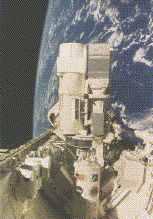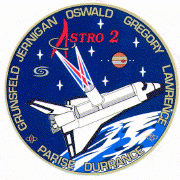 The Flight of Astro-2
The Flight of Astro-2

 The Flight of Astro-2
The Flight of Astro-2

 The three UV telescopes that flew on Astro-1 were reassembled to form
the Astro-2 Observatory and flew on the space shuttle
Endeavour in March 1995. The Astro-2 Spacelab mission stayed in
orbit for 16.5 days (March 2 - 18, 1995) and became the longest space
shuttle flight to date. This was nearly twice as long as the first Astro
mission. Increased observation time coupled with technical improvements
to HUT, the Instrument Pointing System, and the mission planning process
enabled HUT scientists to gather over 5 times more data than they
did during Astro-1.
The three UV telescopes that flew on Astro-1 were reassembled to form
the Astro-2 Observatory and flew on the space shuttle
Endeavour in March 1995. The Astro-2 Spacelab mission stayed in
orbit for 16.5 days (March 2 - 18, 1995) and became the longest space
shuttle flight to date. This was nearly twice as long as the first Astro
mission. Increased observation time coupled with technical improvements
to HUT, the Instrument Pointing System, and the mission planning process
enabled HUT scientists to gather over 5 times more data than they
did during Astro-1.
HUT's science program for Astro-2 was a combination of expanding on results from Astro-1 and breaking new ground. Seldom in astronomy do observations of one or two objects provide a truly general understanding of a whole class. By observing more active galaxies, elliptical galaxies, cataclysmic variables and nebulae, Astro-2 HUT observations provided a much broader understanding of the phenomena involved in these objects. Also, HUT's improved sensitivity for Astro-2 made it possible to observe objects that were too faint previously, permitting whole new science programs to be pursued.
In addition to new faint targets, there were many brighter UV sources that simply could not be observed in the brief time available on Astro-1. For example, many additional hot white dwarf stars, which are extremely faint in visible light but are actually quite bright in the UV, were observed on Astro-2. These stars represent the cores of burnt-out stars that have lost their outer layers, and as such hold many clues to the end point of the evolution of stars similar to our sun. (Link to Scientific Results from HUT for a description of some Astro-2 findings.)
 The
Astro-2 flight crew piloted the shuttle
and operated the telescopes in orbit.
The
Astro-2 flight crew piloted the shuttle
and operated the telescopes in orbit.
Bill Blair (wpb@pha.jhu.edu)